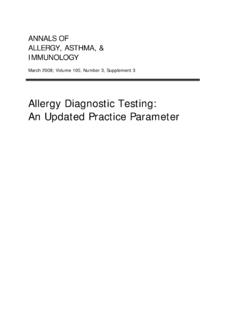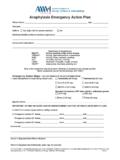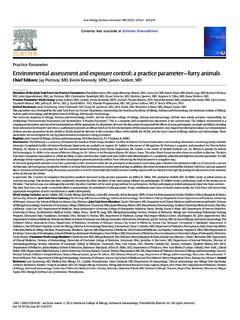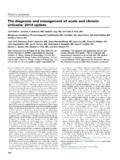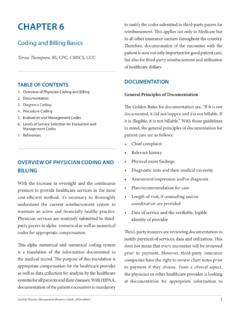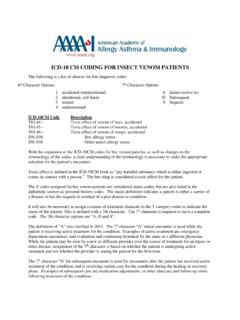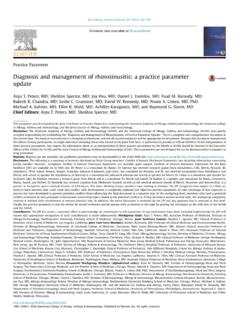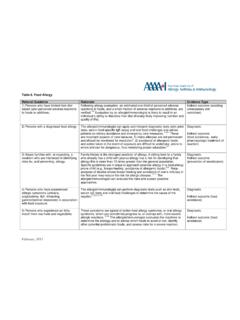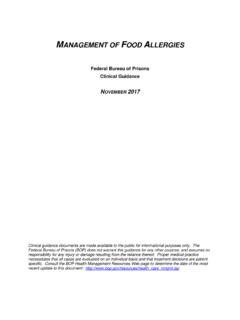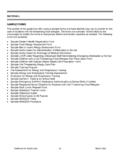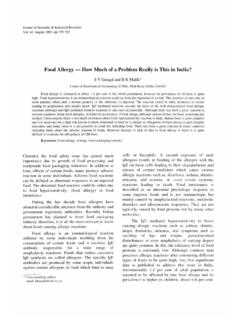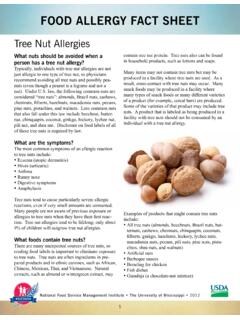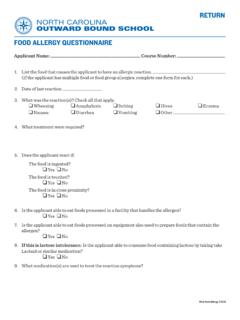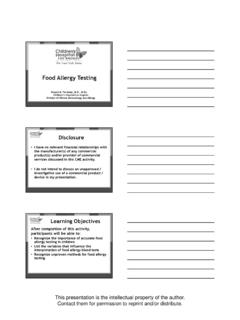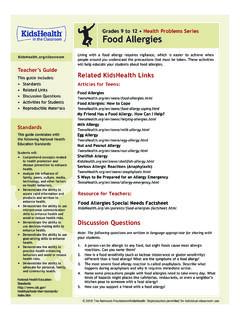Transcription of What you need to know about the new guidelines for the ...
1 Overview The guidelines , sponsored by the NIH(NIAID), are based upon expert opinionand a comprehensive literature had input on the ,2 Definitions food allergy was defined as an adversehealth effect arising from a specific im-mune response. food allergies result in IgE-mediatedimmediate reactions ( , anaphylaxis)and several chronic diseases ( , ente-rocolitis syndromes, eosinophilic esopha -gitis, etc), in which IgE may not play an important and Natural History food allergy is more common in children than adults,but many allergies eventually resolve. Among the most common food allergies in children,milk, egg, wheat and soy allergies often resolve in child-hood; peanut, tree nut, fish and shellfish allergies can re-solve, but are more likely to persist.
2 Peanut allergy prevalence has increased during recentdecades and now affects 1-2% of young Fatal food allergic reactions are usually caused by peanut,tree nuts and seafood, but have also occurred from milk,egg, seeds and other foods. Fatalities have been associated with: age (teenagers andyoung adults), delayed treatment with epinephrine, andco-morbid asthma. Severity of future allergic reactions is not accurately pre-dicted by past history or allergy test food allergy should be suspected when typical symptoms( , urticaria, edema, wheezing, mouth itch, cough,nausea/vomiting, anaphylaxis, etc) occur within minutesto hours of ingesting a food . food allergy rarely causesisolated chronic respiratory symptoms, namely those ofrhinitis and asthma.
3 Tests for food -specific IgE are recom-mended to assist in diagnosis, but shouldnot be relied upon as a sole means to di-agnose food allergy . The medical history/exam are recommended to aid in diag-nosis. A medically monitored feeding( food challenge) is considered the mostdefinitive test for food allergy . food -specific IgE testing has numerouslimitations; positive tests are not intrin-sically diagnostic and reactions some-times occur with negative tests. Theseissues are also reviewed in an AAP Clini -cal food panels with-out considering history is often mis - leading. Tests selected to evaluate food allergy should bebased on the patient s medical history and not compriselarge general panels of food allergens. In the context of moderate to severe atopic dermatitis,children less than 5 years old should be considered forfood allergy evaluation for milk, egg, peanut, wheat, andsoy, if at least 1 of the following conditions is met: 1) The child has persistent AD in spite of optimized management and topical therapy, or 2) the child has a reliable history of an immediate reaction after ingestion of a specific food .
4 Care should be taken to ensure these children are clin-ically allergic to a food prior to removing it completelyfrom their diet because restrictive diets may be harmful. Several tests are not recommended, including food -IgG/IgG4, applied kinesiology, provocation neutraliza-tion, hair analysis, and electrodermal The recommendations for infant diet are in agreementwith the 2008 AAP Clinical Report on this is encouraged for all, if not exclusively breast-feeding, hydrolyzed infant formulas are suggested forinfants at risk (at least 1 first-degree relative, parent orsibling with allergic disease). Complementary foods, in-cluding potential allergens, are not restricted after 4-6months of age (not applicable for infants experiencingallergic reactions).
5 What you need to know about the new guidelines forthe diagnosis and management of food allergy in the THE JOURNAL OF allergy ANDC linical ImmunologyVOLUME 126, NO. 6 DECEMBER toGuidelines for the Diagnosis and Management of food allergy in the United States: Report of the NIAID-Sponsored Expert PanelSupported by the food allergy InitiativeOFFICIAL JOURNAL OFAllergy guidelines insert_Layout 1 9/26/11 1:36 PM Page 1 Management Education about food avoidance is key to prevent reactions. This includes information about label readingand cross-contact of allergens (unintended contamina-tion during food preparation). Nutritional evaluation and growth monitoring of children with food allergy is recommended. It is acknowledged that having a food allergy disruptsquality of life.
6 Advice about influenza vaccination for persons with eggallergy is reviewed, with more options for administrationto those with egg allergy . Management of anaphylaxis emphasizes prompt administration of epinephrine, observation for 4-6 hoursor longer after treatment, education of the family onavoidance, early recognition, treatment, medical iden-tification jewelry, and follow up with a primary healthcare provider and consideration for consultation withan allergist-immunologist. Prescription of epinephrine autoinjectors and patienteducation advice substantially follows the 2007 AAPC linical Report on this topic,5including having 2 dosesavailable, switching from to mg fixed-dose au-toinjectors at approximately 25 kg (55 lbs) in context ofpatient-specific circumstances, having a written emer-gency plan, and providing supporting educational ma-terial.
7 When multiple- food elimination diet is undertaken forsuspected food -exacerbated atopic dermatitis, andeczema subsequently improves, it is essential to performa systematic reintroduction of the eliminated foods. Thiswill help to minimize avoidance of non-allergenic foods,and confirm which foods are clinically relevant. Suggests consideration for a referral to an allergist/im-munologist for testing, diagnosis and ongoing manage-ment. The guidelines do not provide specific advice for schoolmanagement, but these issues were covered in a recentAAP Clinical InformationThis document is only a brief outline of the topics covered by theGuidelines, prepared as a joint effort of the Section on allergy andImmunology of the AAP and the Adverse Reactions to FoodsCommittee of the American Academy of allergy , Asthma andImmunology.
8 The reader is encouraged to refer to the original sourcesfor additional information. The guidelines present a number of re-sources for additional information about food allergies. AAP and se-lected resources are listed here. AAP Section on allergy and Immunology American Academy of allergy , Asthma & Immunology(AAAAI) American College of allergy , Asthma and Immunology(ACAAI) Asthma and allergy Foundation of America (AAFA) Consortium of food allergy Research, food allergy EducationProgram ; food allergy & Anaphylaxis Network (FAAN) ; food allergy Initiative (FAI) Kids With food Allergies (KFA) ; National Institute of allergy and Infectious Diseases (NIAID) : 1. Boyce JA, Assa ad A, Burks AW, Jones SM, Sampson HA, Wood RA et for the Diagnosis and Management of food allergy in the UnitedStates: Summary of the NIAID-Sponsored Expert Panel Report.
9 J allergy ClinImmunol2010; 126(6):1105-18. 2. Burks AW, Jones SM, Boyce JA, Sicherer SH, Wood RA, Assa ad A, et 2010 guidelines for Managing food allergy : Applications inthe Pediatric Population. Pediatrics. 2011;128(5). 3. Sicherer SH, Wood RA. allergy Testing in Childhood: Using Allergen-SpecificIgE Tests. Pediatr. In Greer FR, Sicherer SH, Burks AW. Effects of early nutritional interventions onthe development of atopic disease in infants and children: the role of maternal di-etary restriction, breastfeeding, timing of introduction of complementary foods,and hydrolyzed formulas. Pediatrics2008; 121(1):183-91. 5. Sicherer SH, Simons FE. Self-injectable epinephrine for first-aid management ofanaphylaxis. Pediatrics2007; 119(3) Sicherer SH, Mahr TA; The Section on allergy and Immunology.
10 Managementof food allergy in the SChool Setting. Pediatrics2010; Dec; 126(6) and funding made possible by the AAP Section On allergy and guidelines insert_Layout 1 9/26/11 1:36 PM Page 2
